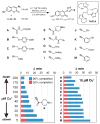Relative performance of alkynes in copper-catalyzed azide-alkyne cycloaddition
- PMID: 23566039
- PMCID: PMC4170714
- DOI: 10.1021/bc300672b
Relative performance of alkynes in copper-catalyzed azide-alkyne cycloaddition
Abstract
Copper-catalyzed azide-alkyne cycloaddition (CuAAC) has found numerous applications in a variety of fields. We report here only modest differences in the reactivity of various classes of terminal alkynes under typical bioconjugative and preparative organic conditions. Propargyl compounds represent an excellent combination of azide reactivity, ease of installation, and cost. Electronically activated propiolamides are slightly more reactive, at the expense of increased propensity for Michael addition. Certain alkynes, including tertiary propargyl carbamates, are not suitable for bioconjugation due to copper-induced fragmentation. A fluorogenic probe based on such reactivity is available in one step from rhodamine 110 and can be useful for optimization of CuAAC conditions.
Figures




Similar articles
-
Quick and highly efficient copper-catalyzed cycloaddition of organic azides with terminal alkynes.Org Biomol Chem. 2012 Jan 14;10(2):229-31. doi: 10.1039/c1ob06190a. Epub 2011 Oct 24. Org Biomol Chem. 2012. PMID: 22024945
-
Structural Determinants of Alkyne Reactivity in Copper-Catalyzed Azide-Alkyne Cycloadditions.Molecules. 2016 Dec 9;21(12):1697. doi: 10.3390/molecules21121697. Molecules. 2016. PMID: 27941684 Free PMC article.
-
Copper-catalyzed azide-alkyne cycloaddition (CuAAC) and beyond: new reactivity of copper(I) acetylides.Chem Soc Rev. 2010 Apr;39(4):1302-15. doi: 10.1039/b904091a. Epub 2010 Mar 4. Chem Soc Rev. 2010. PMID: 20309487 Free PMC article. Review.
-
Synthesis of the copper chelator TGTA and evaluation of its ability to protect biomolecules from copper induced degradation during copper catalyzed azide-alkyne bioconjugation reactions.Org Biomol Chem. 2016 Jan 21;14(3):849-52. doi: 10.1039/c5ob02133b. Epub 2015 Dec 8. Org Biomol Chem. 2016. PMID: 26647226
-
Fluorogenic click reaction.Chem Soc Rev. 2010 Apr;39(4):1233-9. doi: 10.1039/b901975h. Epub 2009 Sep 30. Chem Soc Rev. 2010. PMID: 20309483 Review.
Cited by
-
Steric and stereoscopic disulfide construction for cross-linkage via N-dithiophthalimides.Chem Sci. 2020 Mar 20;11(15):3903-3908. doi: 10.1039/d0sc01060j. Chem Sci. 2020. PMID: 34122859 Free PMC article.
-
Achieving Controlled Biomolecule-Biomaterial Conjugation.Chem Rev. 2018 Aug 22;118(16):7702-7743. doi: 10.1021/acs.chemrev.8b00253. Epub 2018 Jul 24. Chem Rev. 2018. PMID: 30040387 Free PMC article. Review.
-
Unleashing the Power of Bond Cleavage Chemistry in Living Systems.ACS Cent Sci. 2021 Jun 23;7(6):929-943. doi: 10.1021/acscentsci.1c00124. Epub 2021 Apr 30. ACS Cent Sci. 2021. PMID: 34235254 Free PMC article. Review.
-
Development and application of bond cleavage reactions in bioorthogonal chemistry.Nat Chem Biol. 2016 Mar;12(3):129-37. doi: 10.1038/nchembio.2024. Nat Chem Biol. 2016. PMID: 26881764 Review.
-
Chemical Diversification of Simple Synthetic Antibodies.ACS Chem Biol. 2021 Feb 19;16(2):344-359. doi: 10.1021/acschembio.0c00865. Epub 2021 Jan 22. ACS Chem Biol. 2021. PMID: 33482061 Free PMC article.
References
-
- Tornøe CW, Christensen C, Meldal M. Peptidotriazoles on Solid Phase: [1,2,3]-Triazoles by Regiospecific Copper(I)-Catalyzed 1,3-Dipolar Cycloadditions of Terminal Alkynes to Azides. J Org Chem. 2002;67:3057–3062. - PubMed
-
- Rostovtsev VV, Green LG, Fokin VV, Sharpless KB. A Stepwise Huisgen Cycloaddition Process: Copper(I)-Catalyzed Regioselective Ligation of Azides and Terminal Alkynes. Angew Chem, Int Ed. 2002;41:2596–2599. - PubMed
-
- Kolb HC, Finn MG, Sharpless KB. Click Chemistry: Diverse Chemical Function from a Few Good Reactions. Angew Chem Int Ed. 2001;40:2004–2021. - PubMed
-
- Wang Q, Chan TR, Hilgraf R, Fokin VV, Sharpless KB, Finn MG. Bioconjugation by Copper(I)-Catalyzed Azide-Alkyne [3+2] Cycloaddition. J Am Chem Soc. 2003;125:3192–3193. - PubMed
Publication types
MeSH terms
Substances
Grants and funding
LinkOut - more resources
Full Text Sources
Other Literature Sources

